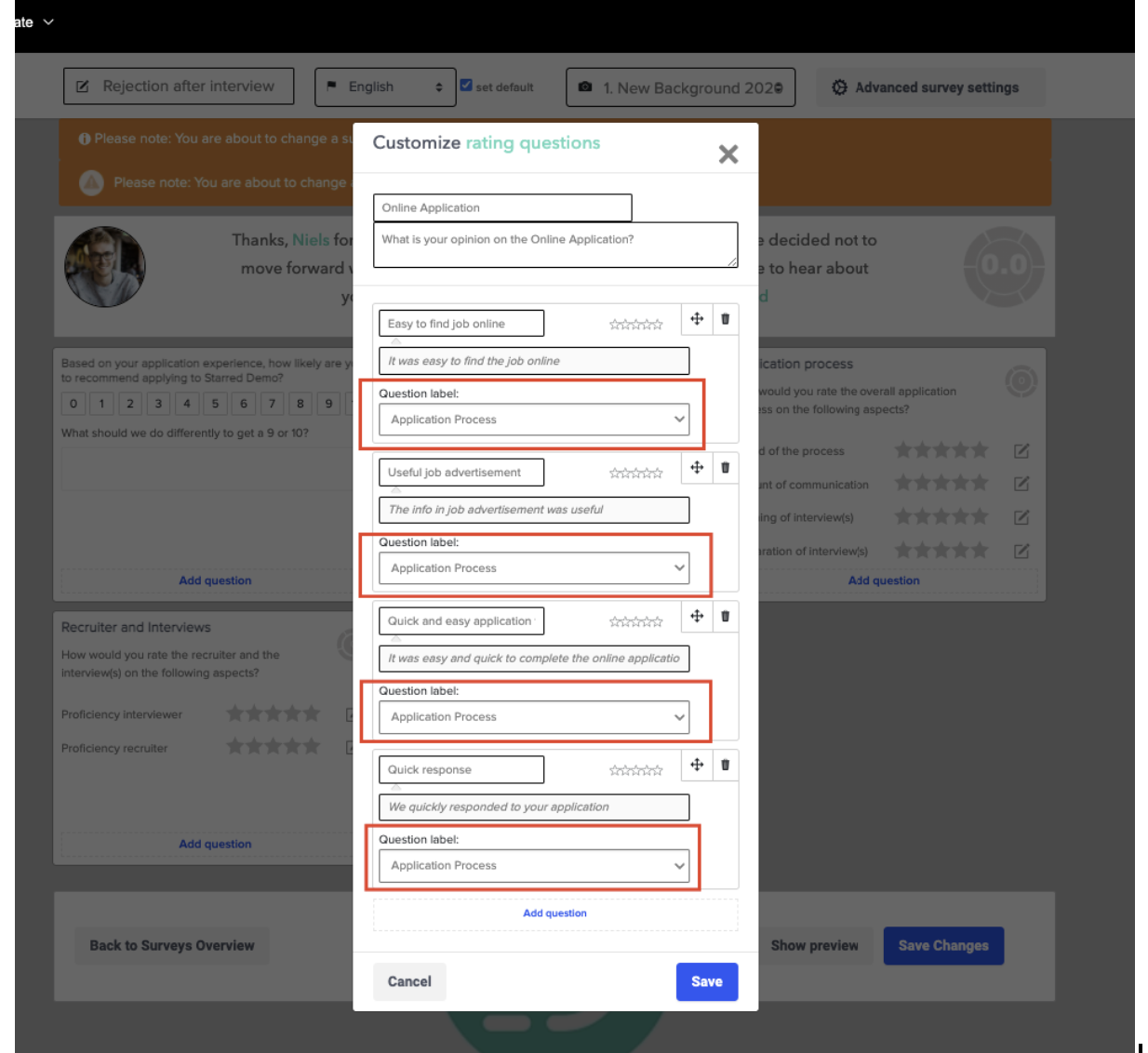Question labels (beta)
Benchmark the drivers of your candidate experience.
What are question labels?
Question labeling allows you to link each survey question to a specific theme in order to:
Understand the drivers of your candidate experience across all surveys
Benchmark themes with other companies to understand where you fall short and what aspects to leverage
At Starred we provide the option to label your survey questions. A question label is a word (or two) that identifies and describes the concepts covered in your survey question. You can find a list of question labels with their definition below.
How do I add labels to my surveys?
Before you start labeling your questions, please note that you can only add question labels to star-rated or 1-10 scale questions.
To add question labels, please follow below steps:
- Navigate to the survey you’d like to add labels for and select ‘Edit’ from the dropdown menu.
- Click on the first question block (star-rated or 1-10 scale).
- Click on the 'Question label' section
- Select the label that best describe your question (if none of our labels are applicable to the question, please leave it blank)
- Click on ‘Save’
- Repeat the above steps for all questions in all question blocks.

Note: If in the future you decide to make changes to the questions in one of your surveys, don’t forget to also edit the 'Question label' and select the label that better describes the content of your (edited) questions.
Note: As these labels will be used to benchmark themes across all of Starred’s customers, please ensure to label each question correctly.
For all survey templates, the question labels are pre-populated.
List of question labels and definitions
Below you find a definition of each question label:
-
Inclusion: used for questions related around how candidates experienced the inclusion of your recruitment process (i.e. ‘Did you feel that you could openly express your ideas or opinions?’ or ‘Did you feel respected during the interviews?’)
-
EVP (Employee Value Proposition): used for questions related to your employer brand and culture. (I.e. 'I gained a good understanding of the culture, values, and mission throughout the interview process.')
-
Feedback: used for questions related to how your candidates experienced the quality of received feedback throughout the recruitment process (i.e. ‘I was provided with a clear explanation of why chose not to move forward with me.’)
-
Application Process: used for questions related to your (online) application process (i.e. ‘It was easy to apply’)
-
Compensation & Benefits: used for questions related to the different aspects in your offer letter (i.e. ‘How satisfied were you with the total compensation offered?’)
-
Scheduling & Planning: used for questions related to the scheduling, planning and coordination of interviews during the recruitment process (i.e. ‘The scheduling of the interview(s) went smoothly’)
-
Onboarding: used for questions related to the onboarding process of a candidate, which includes pre-onboarding (i.e. ‘Did you feel like you had tasks you could start on right away?’)
-
Assessment: used for questions related to how candidates experiences assessment/tests they were asked to complete during the recruitment process (i.e. ‘I recognized the added value of the assessment’)
-
Preparation: used for questions related to how how candidates felt they were being guided and prepared for the different steps/interviews during the recruitment process (i.e. ‘I could tell that the interviewer(s) I spoke with were prepared’)
-
Engagement: used for questions related to how engaged candidates felt that the interviewers were during the interview process (i.e. ‘The interviewer(s) were engaged and interested in me’)
-
Screening: used for questions related to the screening experience (i.e. ‘The recruiting team managed my expectations around the process and timeline’)
-
Understanding the role: used for questions related to how well candidates felt the role was understood throughout the recruitment process (i.e. ‘You had the opportunity to learn about the team and the challenges in the role’)
-
Proficiency/Professionalism: used for questions related to what extent different members of the recruitment/hiring team behaved professionally and proficiently (i.e. ‘My interviews started on time’)
-
Communication: used for questions related to quality and frequency of communication from the recruiting team throughout the recruitment process (i.e. ‘The recruiting team managed my expectations around the process and timeline’)
-
Interview: used for questions related to the overall interview experience and/or atmosphere (i.e. ‘The interviewer(s) provided a safe environment to freely and openly express myself’)
-
Ease of use: used for questions related to the usability of (assessment) tools that were used throughout the recruitment process (i.e. ‘I was satisfied with the functionality of the technical tool’)
Updated over 2 years ago
